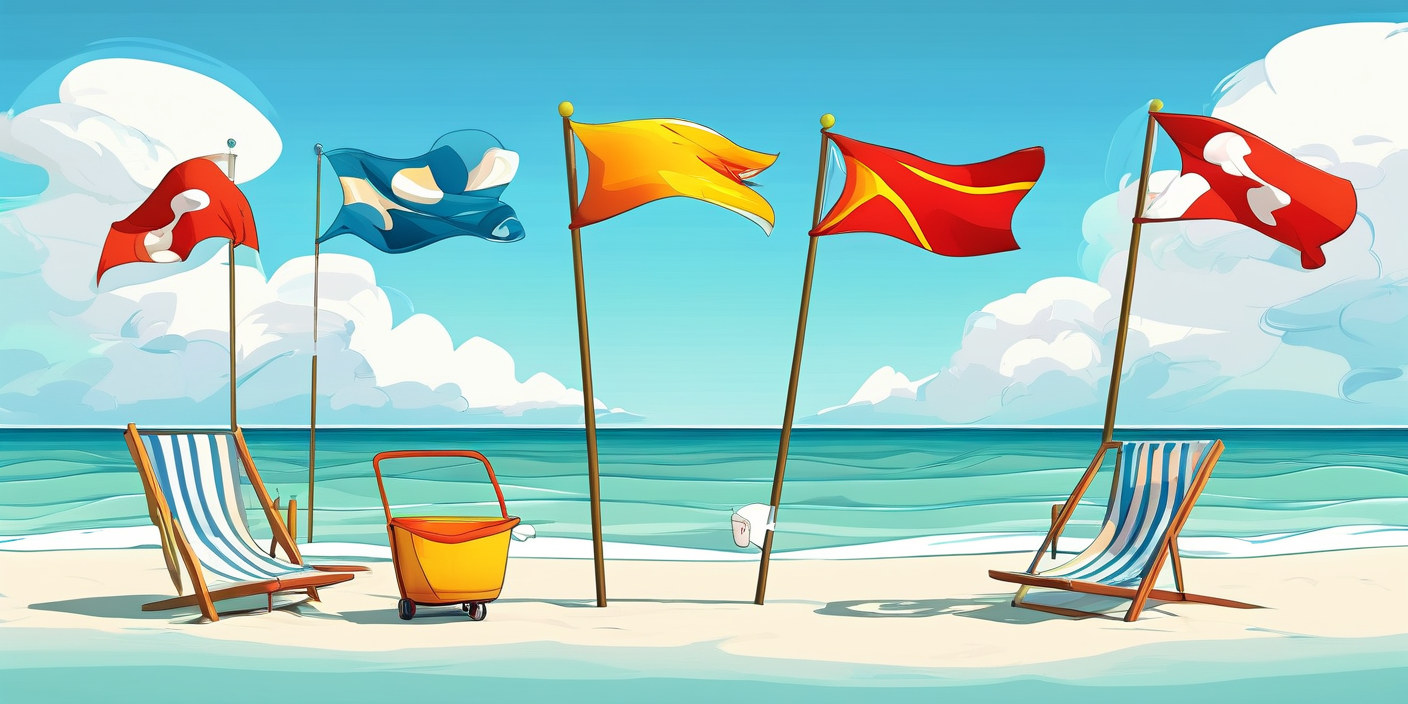Introduction: Understanding Beach Flag Signals
Heading to the beach for a fun-filled day of sun, sand, and surf? Before you dive in, it’s crucial to understand the meaning of the colored flags you might see flying high on lifeguard towers. These flags aren’t just decorative; they’re vital communication tools conveying important information about the current ocean conditions and potential hazards. Ignoring these signals can have serious consequences, putting your safety and the safety of others at risk. This comprehensive guide will break down the most common beach flag colors and their associated meanings, ensuring you can enjoy a safe and enjoyable beach experience.
The Most Common Beach Flag Colors and Their Meanings
While specific flag systems may vary slightly depending on location and local regulations, the following color codes are widely adopted across many beaches globally. Always remember to check for any locally specific signage or ask a lifeguard if you’re unsure.
Red Flag: High Hazard – Stay Out of the Water!
A red flag is the most serious warning. It indicates extremely hazardous conditions, such as strong currents, dangerous riptides, high surf, or other significant dangers. Entering the water under a red flag is highly discouraged and potentially life-threatening. Lifeguards are likely to be actively monitoring the situation and may be unable to provide assistance due to the severity of the conditions. Instead of swimming, enjoy the beach from the shoreline, engaging in activities like sunbathing or building sandcastles.
Yellow Flag: Moderate Hazard – Exercise Caution
A yellow flag signals moderately hazardous conditions. The ocean may have moderate currents, potentially strong waves, or other less severe dangers. While swimming is not strictly prohibited, it’s crucial to exercise extreme caution. Swim only in designated areas supervised by lifeguards and remain aware of your surroundings. It’s advisable to avoid venturing too far from the shore and to stay within your swimming capabilities.
Green Flag: Low Hazard – Proceed with Caution
A green flag indicates relatively calm and safe conditions. While the ocean may still have some minor currents or small waves, they generally pose minimal risk to swimmers. However, caution is always advised. Never underestimate the power of the ocean, and always be aware of your surroundings and limitations. It’s still recommended to swim in designated areas and remain within sight of lifeguards.
Other Flag Colors and Meanings
Beyond the standard red, yellow, and green flags, other colors might be used to indicate specific hazards or advisories. These variations can differ depending on location, so it’s crucial to check local signage or inquire with lifeguards for clarification.
Purple Flag: Dangerous Marine Life
A purple flag often signifies the presence of dangerous marine life, such as jellyfish, stingrays, sharks, or other potentially harmful creatures. While it doesn’t necessarily prohibit swimming, it warns beachgoers to be extra vigilant and aware of the potential risks. Consider wearing protective gear, such as wetsuits or stingray shoes, and avoid areas where marine life is more likely to congregate.
Black Flag: Strong Currents or Dangerous Conditions
A black flag, similar to a red flag, indicates extremely dangerous conditions, often related to strong currents or other significant hazards. The specific meaning might vary depending on the beach, but it always signals that swimming is strongly discouraged.
Double Red Flags: Beach Closure
In some locations, two red flags displayed together indicate a complete beach closure. This means that swimming and all other water activities are strictly prohibited. The beach itself might be closed due to severe weather, contamination, or other safety concerns. Respect the closure and do not enter the water or the restricted beach area.
Factors Influencing Beach Flag Signals
The color of the beach flag is determined by a variety of factors, all impacting the safety of swimmers and beachgoers. Understanding these elements helps you appreciate the importance of heeding the flag warnings.
Wind Conditions:
Strong winds can create hazardous conditions, generating choppy waters, strong currents, and high waves. Wind strength is a major factor in determining the flag color.
Wave Height and Surf Conditions:
Large waves can be dangerous for even experienced swimmers, posing a risk of being swept away or injured. Wave height significantly influences the flag color selection.
Currents and Riptides:
Riptides are powerful currents that can pull swimmers away from the shore. The presence and strength of currents and riptides are critical considerations in determining the flag color.
Weather Conditions:
Severe weather events, such as thunderstorms or heavy rain, can create dangerous conditions and lead to beach closures.
Marine Life Presence:
The presence of dangerous marine life, as previously discussed, warrants the display of a purple flag.
What To Do When You See a Beach Flag
Seeing a beach flag is not merely a suggestion; it’s a critical piece of safety information. Here’s how to react appropriately:
Red or Black Flag:
Stay out of the water completely. Find a safe spot on the beach away from the water’s edge. Never ignore these warnings.
Yellow Flag:
Swim only in designated areas monitored by lifeguards. Stay close to shore and be aware of your surroundings.
Green Flag:
While conditions are generally safe, always remain vigilant. Swim in designated areas and be mindful of potential hazards.
Purple Flag:
Be cautious of marine life. Consider wearing protective gear and avoid areas where marine life is likely to congregate.
Double Red Flags:
The beach is closed. Do not enter the water or restricted areas.
Final Thoughts: Prioritize Safety and Respect the Flags
Understanding the meaning of beach flags is paramount for ensuring a safe and enjoyable day at the beach. These flags are not mere decorations; they are vital safety signals designed to protect you and others. Always respect the flag colors and heed the warnings they convey. Your safety is the top priority, and a little caution can make all the difference between a memorable beach day and a potentially dangerous one.

